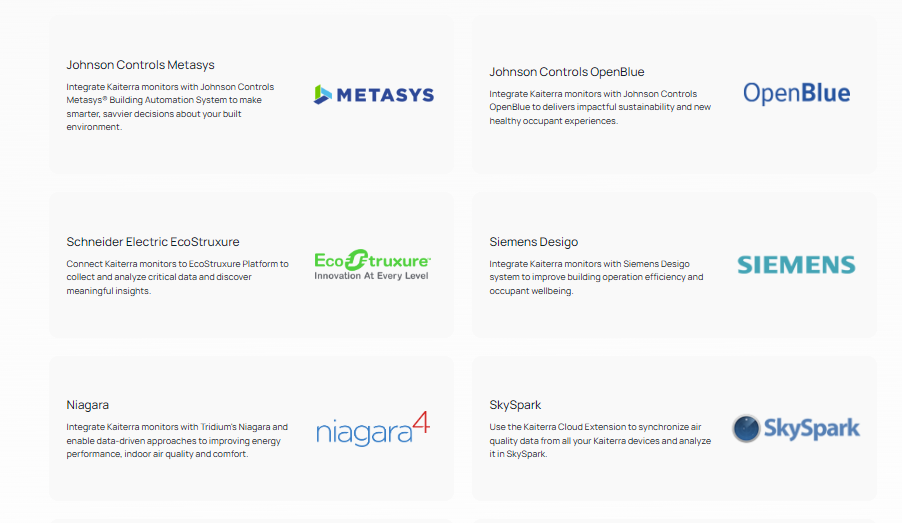Newsletter
Connectivity is key to digital transformation. The Internet of Things (IoT) makes workplaces more measurable via a connected network of devices. Sensors allow businesses to collect data; advanced analytics make it useful. Ways to increase productivity and reduce operational costs arise.
In this article, we'll explain how the IoT is changing the way organizations are monitoring air quality. We'll also cover the 4 key factors you should consider when comparing IoT air quality monitors.
IoT and Indoor Air Quality: How Commercial IAQ Monitors Use IoT Technology
The Internet of Things describes a network of physical devices, connected to the internet and exchanging data. Internet-enabled tech has become ubiquitous in our daily lives - from our phones to our cars and even our household appliances.
Most types of commercial air quality monitors currently on the market are IoT-enabled. How does this come into play? Indoor air quality monitors collect readings for parameters such as volatile organic compounds and carbon dioxide. Connectivity makes it possible to send this data to the cloud where data can be stored, processed, and accessed by apps. Building staff can access IAQ readings remotely, identify areas that suffer from poor air quality, or share information with occupants. Most air quality monitoring systems used in businesses will provide this functionality.
Learn more about Kaiterra’s air quality dashboard.
More advanced use cases of IoT in air quality monitoring go beyond sharing or accessing data. The true challenge is enabling automation to optimize building operations.
Connectivity with building management systems provides new opportunities to improve air quality. IAQ measurements can programmatically trigger changes in other systems (such as HVAC) to optimize indoor environments for comfort and energy efficiency. A good example is demand-controlled ventilation (DCV).
It’s much more energy efficient and healthier to use occupancy and air quality as the HVAC control signal, rather than a simple temperature setting. IoT sensors make it easier to collect and monitor data in more places, ensuring every part of a building is optimized for human comfort while reducing wasted energy. We no longer have to heat and cool unoccupied areas.
What to Look for in an IoT-Enabled Air Quality Monitor
Is your IAQ monitor leveraging the full possibilities of IoT technology? Check for the following:
1. Integration with Existing Building Management Systems
Are you looking to use IAQ data as part of a building automation system? You should choose a device that natively integrates with your existing tech stack.
Native integrations can reduce the need to create custom API connections and help get your system up and running quickly. Check if there is clear and detailed information about which BMS are supported 'out of the box'.
Otherwise, you might find yourself with unplanned engineering overhead of developing custom connections. The effort here could be substantial, increasing the overall costs of your project.

Kaiterra works with most popular BMS providers
2. Support for Building Communication Protocols
Over the years, standardized communication protocols have emerged to enable different business systems to ‘speak’ to one another effectively. This is important when you want to introduce new systems or customize your existing deployment. It's also a way to future-proof your implementation in case components need to be replaced at some point in the future.
Check that your devices robustly support the most widely used building communication protocols. These include BACnet and Modbus. Some vendors claim they support these protocols but do so in a way that’s clunky, poorly-documented, or difficult to implement. Check for case studies or proof of cases where the system has successfully been integrated using these protocols. Third party certification can also validate such claims. (See: Kaiterra Sensedge and Sensedge Mini Earn BTL Certification).

Kaiterra's supports commonly-used communications protocols
3. Security Features
Security is a top priority when implementing any IoT system. You want to prevent unauthorized access to confidential information via the connected system. This is especially important as IoT devices have been used in many recent cyber attacks.
Here are some elements to look out for:
- TLS/SSL encryption.Ensures that only authorized devices can connect to the network.
- SSO (single sign-on).Authenticates users who log into the software side of your IAQ monitoring tool, via your identity management provider.
- 2FA (two-factor authentication). Adds an extra layer of security by requiring both something you know (your password) and something you have (your phone) to login.
- WPA2 Enterprise.Requires users to enter an additional password before they can access wireless networks or resources on them.
You should also check that security is routinely validated by 3rd-party penetration testing.
Learn about security features in Kaiterra.
4. API-First Design
An API is a set of functions, protocols, and tools for software applications. Think of it as a two-sided cable that enables you to connect your devices to other software systems and applications.
An API-first approach means that the IAQ monitoring system is built with an open API at its core. This allows developers to build applications that interact with the data the air quality sensors collect. Data can power additional business apps, web portals, or building management systems.
For a simple example, you might want to send a Slack notification when the air quality drops below a certain level. Or, you might create custom alerts based on specific thermal comfort parameters such as temperature or humidity. An API-first design will make these customizations much easier to implement.
Find Out More About Kaiterra's IoT Technology
We hope this overview will help you better evaluate IAQ technology. Looking for an advanced air quality monitoring solution? Kaiterra is built on years of industry expertise, and designed from the ground-up for a data-driven and connected future. Check out what Kaiterra can do for your business:
- Compare between our enterprise indoor air quality monitors
- Download our guide to high-performance buildings
- Schedule a call with a Kaiterra expert:







.png?width=200&height=148&name=Menu%20C%20(2).png)

.png?width=307&height=228&name=Menu%20-%20D%20(1).png)
.png)

